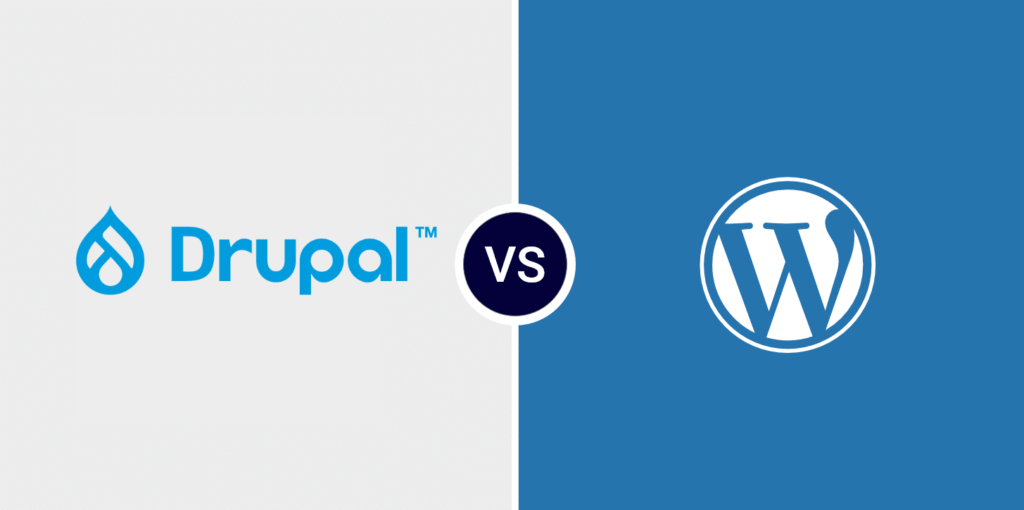In this article, I’ll quickly go over what Drupal and WordPress are and what they are for, what’s the differences between both and as at Outsourcify we’re choosing WordPress over Drupal why and how to migrate an existing Drupal website into a new WordPress website.
It is important to notice that migrating is not simply a matter of shifting your site from one CMS to another. It means basically designing from scratch a brand new website and in a parallel to move the data in Drupal into the new WordPress website.

2 CMS with the same purpose
Drupal and WordPress both are softwares created for the same purpose, to serve as a backbone to manage the content of a dynamic website, they are called Content Management System (CMS). Both offer an administration panel which is directly available after install and gives you an interface on which to manage your website, add pages and blog articles, manage a media library to add images for example to your website. Both use themes to display the website design and inject the data (pages, articles etc) created in the admin panel into it. Themes are folders which have to be uploaded to the CMS software, they include all files that are needed for the CMS to know how to generate the dynamic website.
Of course, Drupal and WordPress aren’t the only CMS available. They both happen to be based on the same technologies, the PHP programming languages and mySQL database. Dozens of other CMS are available in these technologies, Joomla for example, and in other technologies, pretty much every programming language has a few CMS softwares. Drupal and WordPress are open source while many paid solutions also exist.
Why to choose WordPress over Drupal
First I would like to state that there is no real consensus on which CMS is the best, it’s a matter of taste and perspective, and mainly comes down to the perception on the ease of use, the existing expertise the users of a website already have with one tool or the other. Drupal and WordPress are recommended for the same types of websites (corporate websites, blogs), moving from one to another won’t bring many additional features, it will mainly be a matter of user interface and access to a pool of open source plugins. There is no difference in terms of cost or performance, they both run on exactly the same types of servers and they don’t have significant differences in terms of speed.
WordPress has a more user friendly interface
Drupal is just plainly less easy to use, some aspects may even require a developer’s assistance whereas WordPress is created to be user friendly, especially for non technical users. WordPress is arguably the easiest CMS to use between both, especially to expand the functionality of your site (installing a Facebook pixel for example) or customizing the design (adding an information popup) is much more approachable. Drupal is a bit more developer-centered and expect you to know a bit of HTML and PHP, especially if you want to have a custom-looking and custom-operating website.
This can be argued but we feel WordPress’s interface is better for accessibility and ongoing management of the content of a website. The SEO optimization is also more user friendly, because WordPress has better plugins for this.
WordPress is the most popular CMS
WordPress has a huge market share of all CMS based websites (more than 50%) and overall if we consider all websites currently online in 2020, a large percentage runs on WordPress (depending on the sources from 35% to 50%). Drupal and Joomla are far behind (a few %). This means that the WordPress community is much larger, with much more developers familiar with how WordPress works. This also means WordPress has more plugins available and they are updated more regularly. The chance that WordPress will still exist in 10 years is much higher than that of Drupal.
The popularity of WordPress also brings downsides, for example it’s logically much more targeted by attacks and it’s thus more difficult to secure (90% of hacked websites run with WordPress), but this can be safeguarded by strong security measures.
The main reason to migrate is usually a decision taken during the process of redesigning an existing Drupal website and choosing which technology to use for the new website. A change of technology can be considered if the future users of the new website are disappointed with the Drupal experience, have more experience in WordPress or are interested in trying something new.
WordPress has more plugins/modules
Due to its popularity, WordPress has many more plugins (called modules in the Drupal world) and plugins with more advanced features than Drupal. They are also updated more often by specific teams, many companies in the world only produce WordPress plugins. Examples are plugins for translation of a website, for SEO, for security, caching, or plugins that add a whole new set of functionalities like e-commerce plugins, membership management, events management etc.
Manual or automated migration from Drupal to WordPress
Migrating a website consists of actually migrating its data (page content, articles, images etc), in our case the idea is to get the data as it is stored in the initial Drupal mySQL database into a new WordPress database. Unfortunately, it’s not an easy task as both software store the data differently. It’s a task that requires some expertise in databases, but also both on Drupal and WordPress.
In aparté, I would like to note that the ease of use of these CMS means that it’s actually possible to create websites using these technologies with little programming skills, you just need to know how to use the WordPress admin panel interface to create a WordPress website. Many WordPress developers thus are actually WordPress website creators or webmasters but they don’t understand much, if any, of what happens under the hood. When it comes to creating a theme, plugin or in our case migrating data, web programmers are required, experts able to put their hands directly in the PHP code, and work directly on the mySQL database.
The complexity of a migration task implies that every website will require a different process. It mainly depends on the content, if the Drupal website has little content and only simple pages and articles, the process would be straightforward, but in this case a manual migration might be suited as well. An automated migration means using some scripts to automate the migration of the data, this is required if there is too much data to handle manually.

Our process at Outsourcify to migrate
Some initial hosting preparation
We would usually start in all cases by installing a full copy of the Drupal website including all images on one of our development servers, this usually helps to mitigate any error in the process that might be due to outdated servers or inadequate server configurations. We in parallel install a brand new self-hosted WordPress website on another cloud instance. Both websites need to be able to access each other and particularly to move data from the Drupal database to the WordPress database.
Listing all the current website URLs
This step is particularly important for SEO, the objective is to ensure all pages of the existing website have an equivalent in the new website or that some rules are put in place to redirect old URLs to new ones. If the URLS on the Drupal website were not SEO friendly, it’s a good time to improve them. The Screaming Frog SEO Spider is the best tool for quickly grabbing all the URLs of a given site, it’s a desktop software that needs to be installed on your computer.
This step also helps to ensure that all pages of the current website are migrated and no data is forgotten.
Analysis of the Drupal website
The next step is to understand the structure of the current Drupal website and especially to detect any specific custom content that was created. If the Drupal website uses some specific plugins, for example e-commerce plugins, the task’s complexity can grow exponentially.
Migration with the help of a plugin
Hopefully, there are plugins to migrate data, we usually use “FG Drupal to WordPress”. The plugin’s premium edition is most likely needed as it allows you to switch to WordPress custom post forms, post fields and taxonomies. If everything runs smoothly, transfering the content from a website to another is straightforward, but it’s very likely that problems happen with automated site migrations, images are not found, only particle data is exported, character encoding issues are also often found. You often need to restart from scratch and repeat this step in order to fix issues in the process. There is a possibility you will have to manually shift some of your content or even repair items after the migration.
Conclusion
At Outsourcify, we do not specifically recommend to migrate from Drupal to WordPress, it just happens that we have more expertise on WordPress and especially when redesigning an old Drupal website, it seems more logical to move to a CMS we are more comfortable with and that we feel will be easier to use for our clients.

























